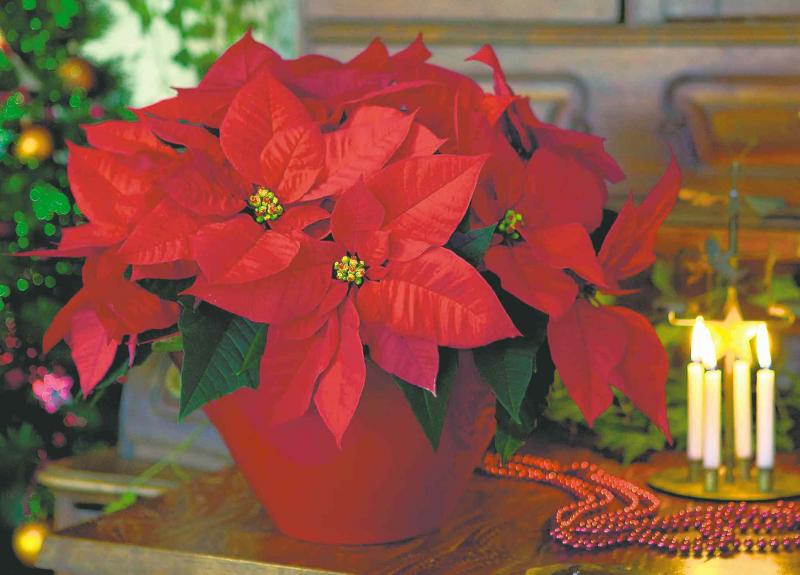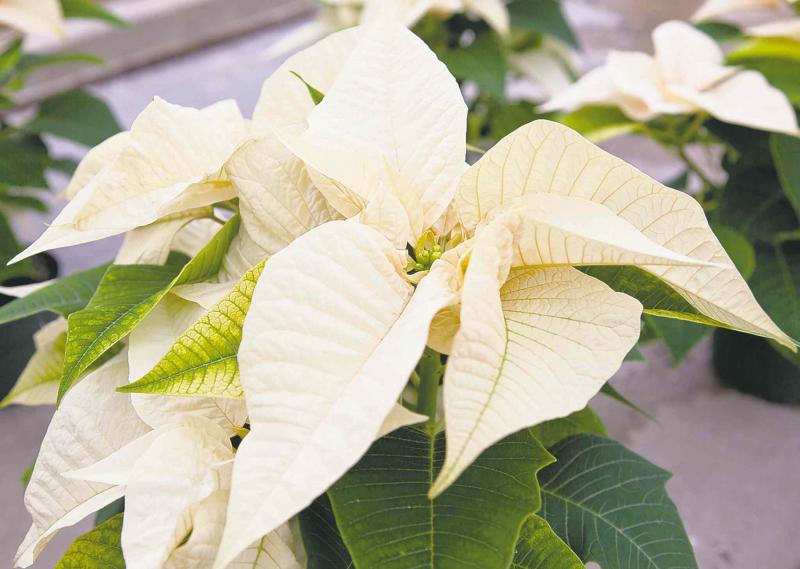
More waste is thrown out during the holiday period than at any other time of the year. Crumpled wrapping paper, hastily torn ribbon, countless boxes, Christmas trees that are losing their needles and near-lifeless poinsettia plants.
Wait, that last one you might be able to keep.
The iconic poinsettia is native to Mexico, where they were once called "flame flowers." The Aztecs used the colourful bracts of the poinsettia (Euphorbia pulcherrima) to produce a red dye. Introduced to the United States in the 1820s, the first potted hybrid was developed by the Ecke family of southern California in the 1920s. Today, nearly 100 years later, the Ecke Ranch is an industry leader in North America and produces new cultivars in many shapes, sizes and forms, including radically different foliage patterns and colours.
Lesli Current, marketing co-ordinator for the Dummen Group, which owns the Ecke Ranch, said the poinsettia is meant to be a seasonal item and there is a six-week time frame where the plant will be at its peak. She added, however, she has a friend who has kept her poinsettia alive for more than a year.
Most homeowners will toss their poinsettia once it begins to drop its coloured bracts and leaves.
How possible is it to bring the poinsettia you purchased this season back into bloom next Christmas? There are a few deciding factors that will determine the longevity of your plant, even if it lasts only a few weeks past Christmas. The plant's chances for survival begin with the quality of the cultivar. Some cultivars have been bred to be longer lasting.
Chad Labbe, co-owner of Shelmerdine Garden Centre, said they start a range of cuttings as early as June or July that are designed to bloom very early, early, mid-season and late season. "We'll have plants right through to Christmas," said Labbe, "but the varieties that are available in mid- to late December will differ from the varieties available in late November."
It is important to know what to look for when you buy your poinsettia. The plant should have dark green leaves that reach almost to the bottom of the container.
The colourful bracts should be richly coloured without any bleached areas. Check for broken branches or missing flowers (the tiny green spherical 'beads' at the base of the faux petals or bracts).
Avoid buying poinsettias that are sitting on the retailer's shelves in their plastic or paper sleeves. Leaf petioles end up being bent during sleeving and the ethylene gas that the poinsettia produces in response will cause the leaves and bracts to droop once the sleeves are removed. The result will be a shorter life span.
Duayne Friesen, Ball Seed Sales representative and host of the Saturday morning program, the Lawn and Garden Journal on the Goldenwest Radio network, said some varieties will have more vigorous root systems than others. "There is one variety," said Friesen, "that is really long lasting and a lot easier for the homeowner to take care of. It's called Bravo and has an incredible root system compared with other varieties.
Plants with smaller root systems may have more dieback, especially if they are overwatered or mistreated."
Now, how might you mistreat a poinsettia? Since poinsettias are tropical plants, they are sensitive to cold temperatures. Place them on a cold window sill or near a drafty door, and the plant will soon drop its leaves or bracts will discolour. Instead, place your poinsettia near an east- or south-facing window where it will receive four to eight hours of indirect sunlight.
If indirect natural light is scarce or unavailable, use bulbs that are incandescent or cool-white fluorescent. Temperature is very important. Maintaining a consistent temperature between 19 C to 23 degrees C will help to prevent leaf drop.
"Water management is key," said Labbe. "It's better to under water than over water. Poinsettias don't need a lot of moisture to recover."
They won't recover, however, from standing in water, so be sure to remove them from the foil cover at time of purchase and keep the soil moist at all times, watering the top 1.27 cm when it begins to dry out.
Labbe, who has visited the Ecke Ranch during the California spring trials, said Ice Punch is a popular variety. An award-winning variety, it features a patterned bract that sports cranberry and frosty white colouring.
Both Labbe and Friesen acknowledge consumers won't find plant tags that identify the variety. "When they go on the shelf they are not labelled," said Friesen.
"Poinsettias cannot be compared with bedding plants. It's not a category where the emphasis is on the hottest new variety. Research goes into what will allow growers to grow them successfully rather than producing a fashion statement."
That being said, there are numerous varieties available. If you are looking for a particular variety, ask at the greenhouse or stop by the Assiniboine Park Conservatory, which displays the names of each plant.
Wade Meisner, horticulture design supervisor, said four different varieties were on display in early December and burgundy-coloured poinsettias are now on display, to the tune of a staggering 1,200 to 1,400 plants.
"We have Freedom Early Red, Freedom Early White, Marble Star and Marin", said Meisner who added the pink-coloured Marin variety almost looks like ketchup chips.
"We bring them in as plugs and grow them in the greenhouse", said Meisner. "A homeowner can try to keep them growing and plant them outdoors in the summer but the trick is to provide them with 12 hours of total darkness."
Meisner said even car lights flashing on the plants for a short time will confuse them enough to not set flower.
"One year, we had a safety light that came on accidentally, so about one-tenth of the plants in the greenhouse did not flower."
Although the poinsettia will begin to drop its bracts and leaves as part of the natural aging process, continue to provide six to eight hours of indirect sunlight until the spring and do not fertilize until it begins to grow again. The remaining bracts will also change colour and turn green. Use a half-strength houseplant fertilizer in proportion to the amount of water you are applying to the plant. Once all risk of frost has passed, place your plant in a shaded area, pinching it back aggressively to about eight centimetres.
By the first week of September, bring your plant indoors before night time temperatures dip to 10 C. This is the most critical time for your poinsettia if you hope to have blooms for Christmas. Using a light cardboard box with seams that are securely taped to block out any light, cover the entire poinsettia every night for at least 14 hours until approximately Nov. 10. The plant should continue to be watered and fertilized as needed. Hopefully, the bracts will begin to turn red.
If not, then you can find comfort in selecting from the many varieties that your greenhouse will offer next season.
Most of us eat way too much during the holidays and some of us eat things we wish we hadn't eaten. This holiday season the Manitoba Poison Centre hotline will receive scores of calls from worried parents whose children have sampled or may have sampled some parts of a poinsettia. If you avoid buying a poinsettia because of the long-held belief it is toxic, reputable sources now tell us the poinsettia is not poisonous.
The federal government's poisonous plants information system says "poinsettia should no longer be regarded as a severely toxic plant." It does, however, produce a milky sap that can irritate or burn skin and eyes.




